New Mars Forums
You are not logged in.
- Topics: Active | Unanswered
Announcement
#1 2016-04-02 18:15:16
- RobertDyck
- Moderator
- From: Winnipeg, Canada
- Registered: 2002-08-20
- Posts: 8,291
- Website
NERVA - 1968 vision for Mars
From the Mars Society group on Facebook. Someone just posted a link to a YouTube video: 22 minutes, 42 seconds.
Nuclear Propulsion In Space 1968 NERVA Manned Mars mission NASA video
Also from the same Facebook post...
The Boeing IMIS study
IMIS-After-Apollo
Camp Century, nuclear powered outpost:
US Army's Top Secret - Camp Century Restored - Declassified Film
Offline
Like button can go here
#2 2016-04-02 19:28:13
- Tom Kalbfus
- Banned
- Registered: 2006-08-16
- Posts: 4,401
Re: NERVA - 1968 vision for Mars
Nerva is among the range of possibilities for interplanetary transportation, more politically acceptable that the Orion Nuclear Pulse engine, I believe. I think we might also consider the nuclear saltwater rocket.
Offline
Like button can go here
#3 2023-03-09 12:02:59
- tahanson43206
- Moderator
- Registered: 2018-04-27
- Posts: 23,397
Re: NERVA - 1968 vision for Mars
NSS Houston meeting this Saturday ... free to public via Zoom
Update .... new item ... talk on NERVA rocket
Saturday, March 11 at 2PM at Barbara Bush Library
Join us for our Monthly NSS North Houston Space Society (http://NorthHoustonSpace.org) meeting. Connect with others who are excited about exploring the cosmos, learning how to use the resources of space to improve human life, and who want to go and spread humanity to the rest of the universe.
This will be a hybrid meeting. Come in person at Barbara Bush Library (6817 Cypresswood Drive, Spring, TX 77379) or join us online Via ZOOM: https://us02web.zoom.us/j/85216600533
The meeting will be on Saturday, March 11, 2023 at 2PM (US Central Time).
2:00 PM – Opening Remarks – Nathan Price
2:05 PM – Recent Space News – Greg Stanley
2:20 PM – Science and Engineering Fair of Houston (SEFH) – Nova Spotlight Awards Overview
2:30 PM – Presentations by Winning Teams3:00 PM – NERVA Rocket Engine Update (Nuclear Propulsion) – Doug Hall
3:40 PM – Socializing
4:00 PM – End of Meeting
(th)
Offline
Like button can go here
#4 2023-03-14 14:39:12
- tahanson43206
- Moderator
- Registered: 2018-04-27
- Posts: 23,397
Re: NERVA - 1968 vision for Mars
I just received an inquiry about the NERVA book I have, from the gent who will be giving the talk on NERVA next month at the NSS meeting.
His talk was postponed due to extended questions of the students who presented their Science Fair topics.
It turns out the NERVA presenter owns a copy of the first NERVA book by James Dewar, and I own the second, so I gave him the Amazon link for the second book.
I also did a quick lookup at TheSpaceShow.com for "dewar" and found at least two interviews.
https://www.thespaceshow.com/search-page?keys=dewar
The next NSS meeting for North Houston will be the First Saturday instead of the second, due to the holiday season.
(th)
Offline
Like button can go here
#5 2023-06-25 11:51:30
- Calliban
- Member
- From: Northern England, UK
- Registered: 2019-08-18
- Posts: 4,266
Re: NERVA - 1968 vision for Mars
One option that we may have for large interplanetary ships, is a fusion-fission hybrid NERVA concept. The idea in this case, is to use fission triggered inertial confinement fusion to generate fast neutrons that then fission 238U. Such an engine would not need enriched uranium or plutonium to generate power. Natural uranium could serve as fuel, because the 14-MeV neutrons released by fusion, will fast-fission 238U. NASA's experiments with lattice confinement fusion could yield fruits in this way as well. We could manufacture such as engines on Mars, using material mined on Mars. We would not need the expense of uranium enrichment, aside from perhaps the tiny amounts needed for hot spot ignition in the IC fusion pellets.
If hybrid fusion-fission can be realised, it also avoids the need for reprocessing or the shipping of enriched uranium to Mars for powerplants. We start with Martian natural uranium and burn it up to about 10 atom%. Such a powerplant would get 20-30× as much energy per unit of natural uranium as conventional enrichment. So we could store the small amount of discharged fuel (1m3 per GWe-yr) in an underground waste repository and use the decay heat to heat Martian greenhouses.
Last edited by Calliban (2023-06-25 12:07:11)
"Plan and prepare for every possibility, and you will never act. It is nobler to have courage as we stumble into half the things we fear than to analyse every possible obstacle and begin nothing. Great things are achieved by embracing great dangers."
Offline
Like button can go here
#6 2023-06-26 10:04:41
- RobertDyck
- Moderator
- From: Winnipeg, Canada
- Registered: 2002-08-20
- Posts: 8,291
- Website
Re: NERVA - 1968 vision for Mars
If the goal is to use natural uranium, it's already been done. Canada developed the CanDU reactor in the 1950s and '60s. The name stands for Canadian Deuterium-Uranium. It's a heavy water reactor, meaning heavy water is used as primary reactor coolant. Heavy water also acts as a neutron moderator, so if the reactor loses coolant the reaction will die down and stop. A deliberate safety feature. Fuel is uranium oxide powder known as yellow cake, stuffed into stainless steel tubes. The tubes are arranged in a frame with several tubes in parallel. Coolant water washes over the tubes. And just to confirm, although uranium is highly refined (yellow cake has very few impurities) it is not enriched at all.
This was done so the reactor could be sold to countries that do not have nuclear weapons. The reactor does not require any enrichment technology at all. Unfortunately it had a few other issues. It turned out to be the second.ost efficient at producing plutonium; second only to a military breeder reactor. And it's the world's most efficient producer of tritium, a component required for fusion warheads. So export is still restricted.
CanDU does not consume all nuclear fuel. After operating for a certain time, fuel rods accumulate nuclear waste that "poisons" the reaction. Once a fuel rod produces too little heat, it is removed from the reactor to cool down. Ideally this could be reprocessed. That means separation of waste from unused fuel. The unused fuel could be used in fresh fuel rods. Europe has a reprocessing facility, but Canada never made use of it, and neither Canada nor the US ever built one of their own.
Offline
Like button can go here
#7 2023-06-26 13:43:44
- GW Johnson
- Member
- From: McGregor, Texas USA
- Registered: 2011-12-04
- Posts: 6,101
- Website
Re: NERVA - 1968 vision for Mars
Dare believe nothing yet that has anything to do with fusion, other than nuclear explosives. The "scientific breakeven" that the NIF recently achieved is orders of magnitude short of anything that might possibly be practical. And they freely admit that. The real trend is that controlled thermonuclear fusion has been "just around the corner" for some 73 years now. Which suggests you should NOT be holding your breath waiting for it!
The only thermonuclear fusion that we actually know how to do is the fusion bomb, first tested 71 years ago. By 69 years ago, it shrank from the size of 4-story building to something that a B-36 could carry 1 of. By 60 years ago it was small enough to fit atop a Minuteman-1 ICBM. It's only shrunk a tad since then. That's a working, practical technology.
About the only non-destructive use for thermonuclear explosives would be a thermonuclear upgrade to the nuclear-fission-powered nuclear explosion drive of old "Project Orion", from the mid 50's into the mid 60's. That sort of thing was only efficient in very large, massive vehicle designs near the 10-20,000 ton class with small fission bombs back then. You might be looking at 100,000+ ton designs if you upgrade it to thermonuclear explosives. But you still suffer the then-unanticipated EMP side effects, no matter what.
Those EMP effects were identified (DOD's noses rubbed in it, actually) by the Starfish Prime megaton-range space nuclear detonation test of 1962 some 200 miles straight up over Johnston Island in the Pacific. It did unexpected electrical grid and telephone damage in Oahu, 900 miles away, and back in the vacuum tube days, before the advent of solid state electronics that we now know is so vulnerable to EMP.
As for doing nuclear thermal propulsion with a natural uranium design, how will you get the neutron moderation unless your working fluid is heavy water? NOT affordable to go that way! Such an approach is more than deserving of investigation, to see if such objections can be overcome. But it is utter folly to make any claims as to the benefits of such a technology, until it has been investigated and tested. CANDU was to be a steam generator for an electric power plant. Nobody ever looked at how to concentrate the heat produced per unit volume, or whether it could use anything other than heavy water as its liquid working fluid.
GW
Last edited by GW Johnson (2023-06-26 13:46:51)
GW Johnson
McGregor, Texas
"There is nothing as expensive as a dead crew, especially one dead from a bad management decision"
Offline
Like button can go here
#8 2023-06-26 14:48:37
- tahanson43206
- Moderator
- Registered: 2018-04-27
- Posts: 23,397
Re: NERVA - 1968 vision for Mars
For Calliban re topic development ...
GW Johnson has just provided you with what (appears to me to be/looks like) a neat opportunity to help all of us (members and readers alike) to better understand the hybrid concept you've been working on in other topics.
GW said:
As for doing nuclear thermal propulsion with a natural uranium design, how will you get the neutron moderation unless your working fluid is heavy water? NOT affordable to go that way! Such an approach is more than deserving of investigation, to see if such objections can be overcome.
It seems to me fair for you to expect your member readers to be willing to invest some time reading other materials you may suggest.
However, it might be tempting to try to handle GW's question in a single post .... please consider designing a learning sequence, in which GW demonstrates mastery of elements you will assemble to provide a comprehensive answer.
You can see an example of that method in the class structure we have created for the class on Basic Orbital Mechanics.
if you should be inspired to develop a similar educational structure, I am more than happy to assist with structure and support mechanisms that seem to be working.
(th)
Offline
Like button can go here
#9 2023-06-26 15:25:52
- kbd512
- Administrator
- Registered: 2015-01-02
- Posts: 8,346
Re: NERVA - 1968 vision for Mars
GW,
Solid state electronics are less vulnerable to most forms of EMP associated with nuclear weapons. There's a lot of mythology about EMP and solid state electronics that's simply not true. The electronics of the 1950s had lots of very long, thin, unshielded copper wires in them. That was how they made both power transformers and capacitors, used in devices such as radio tuning circuitry and telephones.
We still use stuff like that in our power grid, and microelectronics would be more easily fried if they were connected to something, but iPhones and laptops not connected to a power outlet would be almost immune to the effects of EMP from nuclear weapons. You may get a temporary corruption of data, or maybe not even that much. However, an EMP would take down the power grid, no sweat, because the power grid contains lots of unshielded wiring of the correct length to conduct voltage into. Said EMP would have almost no effect on cars, aircraft control systems, and personal electronics in your pocket, except for the minor problem of no longer having any electrical power to use them.
Think about it. EMP is a fast-rise transient pulse of electricity conducted through the atmosphere and into exposed wiring, like antennas of the correct length to conduct voltage into (think very long wires and power transformers). A lightning strike on an aircraft is wildly in excess of the voltages and amperages generated by nuclear weapons, and most commercial aircraft get struck by lightning once or twice per year. Pretty much none of them fall out of the sky afterwards. A computer virus, on the other hand, could both render the software unusable and even fry the electronics.
EMP fried the phone system in Oahu because every single telephone from that era had large coils of very thin wiring in them. I used to have one for reference purposes, so it's easy to see how the EMP conducted the voltage into the wiring and fused the parts of the circuitry with exposed wiring. The exact same thing can happen to microelectronics in other ways, such as ESD. A cell phone in your pocket, a computer in a car or aircraft, has no easy path to ground. For the most part, those devices will be just fine.
I don't lose too much sleep over cell phones getting fried. Maybe people will notice that other people are around them. I worry a lot more over the potential to not have electrical power for months on-end. On top of that, there's the whole "getting your insides turned into jello" from the blast over-pressure of a megaton-class nuclear weapon, second and third degree burns on any exposed skin, plus the lawlessness for those unlucky enough to survive the rest of that. All in all, not my idea of a fun time.
Offline
Like button can go here
#10 2023-06-26 17:34:14
- RobertDyck
- Moderator
- From: Winnipeg, Canada
- Registered: 2002-08-20
- Posts: 8,291
- Website
Re: NERVA - 1968 vision for Mars
I mentioned CanDU for a power plant on the surface of Mars. Using steam turbines. Waste heat could heat habits. Or perhaps the ice of a frozen lake. I still like the frozen pack ice of Elysium Planetia. Melted iced could be sucked up as source water for the community.
But for an interplanetary spacecraft? I looked at it; reactor mass was way too high. And realize the CanDU reaction cycle. Natural uranium has 0.7200% by atoms U-235, or 0.711% by weight. Moderated neutrons absorbed by U-238 will not split, instead becoming U-239. That has a half-life of 23.45(±0.02) minutes, decaying via beta emission 80% of the time to Np-239, the other 20% decays via alpha emission to Th-235. Np-239 has a half-life of 2.355 days, decaying via beta emission to Pu-239. Pu-239 has a half-life of 24,110 years, so it isn't going anywhere; however it's fissile. Once a moderated neutron strikes Pu-239, it splits (fission). Th-235 half-life is 7.2 minutes, decaying via beta to Pa-235. Its half-life 24.44 minutes, beta decay to U-235. Of course U-235 will fission. This is such a slow process that it's ideal for a power plant, but not for a vehicle.
CanDU uses heavy water. Too expensive? Why? Just do it. Who said building a nuclear power plant would be simple or easy? I believe Mars has slightly higher ratio of deuterium per hydrogen atom. Most likely due to losing protium (normal hydrogen) to space.
An alternative is a thorium reactor. On Earth there is 3 times as much thorium as uranium, and 100% of thorium in nature is Th-232. That will absorb a moderated neutron to become Th-233, which will decay via a few steps to U-233. Of course U-233 is fissile. I could list the decay steps, but you get the idea, it also takes days. Again ideal for a power plant; not ideal for a spacecraft or any vehicle.
Offline
Like button can go here
#11 2023-06-27 05:52:02
- Calliban
- Member
- From: Northern England, UK
- Registered: 2019-08-18
- Posts: 4,266
Re: NERVA - 1968 vision for Mars
There are two different possible concepts here involving natural uranium.
1. A pure fission reactor, using natural uranium as fuel, hydrogen as propellant and heavy water or carbon as moderator. This would work, but would be large and heavy and would suffer relatively poor thrust-mass ratio and low power density. It could be used to propel a large ship. The parasitic neutron absorption of hydrogen, requires that the engine operates either at relatively low pressure or in pulsed mode. The only advantage that a natural-U NERVA design offers is its potential to source fissile material from Mars, rather than lift it from Earth. Most historical NERVA designs used HEU, which is a highly restricted material.
2. The fusion-fission hybrid design. In this design, we do not need to rely upon the reactivity of the thin gruel of 235U in NU. We are using inertial confinement fusion to produce fast neutrons, which then cause fast-fission in natural U fuel around the reaction chamber. It is the fast-fission that generates the heat that heats up the hydrogen propellant. The IC fusion does not need to achieve break-even, we are using it as a neutron source, not as an energy source. The IC fusion could also employ tiny amounts of HEU as hot spot ignition triggers at the core of each pellet. This dramatically simplifies ignition, as the driver need only provide compression to the pellets.
The second option could provide a compact engine, but the driver assemblies that trigger IC fusion could be very bulky. By far the easiest design option is a pure fission device employing HEU oxide or carbide fuel and a carbon moderator. The natural U and hybrid engines are only relevant if that proves to be politically unachievable.
NU fast-fission reactors are a plausible option for Martian surface power as well. But their practicality really depends upon the practicality of using small amounts of fissile material as hot spot triggers for IC fusion. Without that innovation, the drivers will be too massive and bulky to ship to Mars and far too complex to build there with ISRU. The hybrid fusion option is really a fission power source. The idea is to use the neutrons produced by fusion to fission 238U, which is not fissionable with slow neutrons. These reactors do not need to rely on 239Pu breeding and reprocessing, so could use Martian natural U as a fuel source. Burnup of the natural U should be at least 10%. This means that even very poor and diffuse Martian uranium deposits would yield high net energy.
Last edited by Calliban (2023-06-27 06:06:15)
"Plan and prepare for every possibility, and you will never act. It is nobler to have courage as we stumble into half the things we fear than to analyse every possible obstacle and begin nothing. Great things are achieved by embracing great dangers."
Offline
Like button can go here
#12 2023-06-27 08:36:50
- GW Johnson
- Member
- From: McGregor, Texas USA
- Registered: 2011-12-04
- Posts: 6,101
- Website
Re: NERVA - 1968 vision for Mars
Where I said the heavy water would be unaffordable was in reference to a nuclear thermal rocket using a natural uranium core. Thermal rockets are inherently open cycle with their working fluid. For a power reactor, the working fluid is recycled, and heavy water becomes quite feasible. Actually I quite liked the CANDU design. But the people building warheads did not.
The rather large and heavy natural uranium core occurs because the reaction is essentially rather "dilute" within a large mass. That's not a recipe for effective propulsion. The advantage of highly enriched uranium and possibly plutonium is that those reactions are "concentrated" within smaller masses, and those could be attractive for thermal rocket application. We already know HEU worked in NERVA. Plutonium has serious handling and safety problems, and was never used by itself for a rocket engine core. I think there might have been some mixed-fuel cores tested in the propulsion programs, but memory does not serve.
For most of my defense engineering career (long ago), solid state electronics were considered highly vulnerable to nuclear EMP, while vacuum tube electronics were considered to be substantially less vulnerable. I have no direct test experience myself, I just know what we were all told, as regards the design of weapons "hard" enough to be used on a nuclear battlefield. Perhaps we were lied to, but if not, then I have to disagree with what Kbd512 said above, about EMP vulnerabilities of modern electronics.
GW
Last edited by GW Johnson (2023-06-27 08:39:06)
GW Johnson
McGregor, Texas
"There is nothing as expensive as a dead crew, especially one dead from a bad management decision"
Offline
Like button can go here
#13 2023-06-27 09:14:56
- Calliban
- Member
- From: Northern England, UK
- Registered: 2019-08-18
- Posts: 4,266
Re: NERVA - 1968 vision for Mars
EMP occurs when gamma rays cause ionisation in the upper atmosphere, which generates voltage gradients as the electrons flow along the Earth's magnetic field lines. Sufficient voltage spikes can be induced in long power cables to cause damage in grid connected equipment and even trip out transformers covering large geographic regions. We see similar problems due to solar storms, which involve charged particles hitting the upper atmosphere.
EMP tends to be more problematic in fission rather than fusion detonations. This is because about 5% of fission energy is released as gamma rays during, or very shortly after fission. But this is only a problem due to very intense bursts of gamma radiation hitting the upper atmosphere - the sort of release that occurs during high yield nuclear explosions within the upper atmosphere. A bomb releases huge flux of gamma rays in the first microsecond of a detonation. It is the amplitude of the pulse that causes the problem, not the area under the curve. A space drive that emits a the same gamma energy continuously, rather than in pulses, would not generate this effect.
The intensity of the pulse is a function of bomb yield. NERVA does not present an EMP hazard, because the gamma ray flux (gamma energy / time) is negligible compared to a fission bomb detonation. Fusion-fission micro-explosions, may or may not present an EMP hazard. Again, the important question is gamma ray flux hitting the atmosphere. If pulse units are individually small and/or modified to absorb gamma rays, the problem is greatly reduced. This remains true even if their total combined yield is much greater than a comparable nuclear weapon, because the release is spread out over greater time.
Nuclear pulse propulsion may present a different hazard to satellites if it floods near Earth space with plasma that is locally trapped by Earth's magnetic field. That is seperate from the EMP problem. It is a hazard to anything in orbit, but not a hazard to things on the ground. It could be a problem regardless of how the plasma is generated.
"Plan and prepare for every possibility, and you will never act. It is nobler to have courage as we stumble into half the things we fear than to analyse every possible obstacle and begin nothing. Great things are achieved by embracing great dangers."
Offline
Like button can go here
#14 2023-06-27 09:26:33
- Calliban
- Member
- From: Northern England, UK
- Registered: 2019-08-18
- Posts: 4,266
Re: NERVA - 1968 vision for Mars
Regarding heavy water moderated rockets. Obviously, the heavy water must be kept cold, whereas the hydrogen exhaust will be hot, at least 2000K. The only way to reconcile this difference is for the fuel to be housed in pressure tubes, which run through a moderator tank but are not in physical contact with it. Neutrons will exit the fuel tubes and will thermalise in the heavy water, before reentering the fuel and xausing fission. About 10% of fission energy is carried away by gamma and neutron fluxes. A portion of this, maybe 5%, will be deposited in the heavy water as it moderates the neutrons. So the tank must be cooled to release this heat and prevent the D2O from boiling. This could be done with a seperate radiator cooling loop, or by passing the hydrogen coolant through the heavy water tank, preheating the hydrogen.
I agree with GW, that the large mass of a natural uranium system is not optimum for propulsion. It would result in low T/W ratio. But for interplanetary ships that can accelerate more gradually, it is something that could work. The bigger question is whether it is worth building such heavy propulsion systems, just to avoid launching enriched uranium from Earth. Probably not.
A fusion-fission hybrid system is an entirely different concept. But it could ultimately have the same problem of low T/W. Using fission to trigger the fusion reaction and then using fusion neutrons to create more fission, is a way of getting past the problem of driver assemblies that would fill a football pitch. But the system would still be quite bulky. Both systems only make sense for propelling relatively large ships in the 1000+ tonne range.
Last edited by Calliban (2023-06-27 09:34:50)
"Plan and prepare for every possibility, and you will never act. It is nobler to have courage as we stumble into half the things we fear than to analyse every possible obstacle and begin nothing. Great things are achieved by embracing great dangers."
Offline
Like button can go here
#15 2023-06-27 10:07:01
- kbd512
- Administrator
- Registered: 2015-01-02
- Posts: 8,346
Re: NERVA - 1968 vision for Mars
Bruce Nuclear Generating Station in canada produces 22,656,000,000Wht on a land area of 9,307,770m^2. Thermal output is 2,434W/m^2. This is about 2.5X solar radiation intensity at high noon over an equatorial desert here on Earth (a multiple of what's available at any time or place on Mars), except that Bruce's capacity factor is 87%. Whether or not the Canadians throw away all the thermal output from their reactors, is irrelevant. The fact of the matter is that the thermal power output is enormous.
28.9% of the thermal power is converted into electricity. That leaves the other 70% (15,859MWt) available for consumption as hot water. You're going to need massive amounts of thermal power on Mars. It's colder than Antarctica. You'll need about 3X more energy to flash evaporate water on Mars to convert it into potable water for drinking, farming, cooking, and cleaning.
Nuclear reactors also have some of the longest continuous runs of power output, some spanning multiple years of operation.
CANDU seems to be a candidate for a large thermal and electrical generating station on Mars, of the kind required to support an entire city.
However, Bruce generates enough total power for only around a quarter million people on Mars, so you need 4X Bruce's total capacity, at a minimum, to support a colony of a million people. The appetite for electrical and thermal power will be sky-high for a place that desolate and cold. I'm also assuming that the natural light greenhouses that RobertDyck proposed will be used instead of artificial light farming.
Offline
Like button can go here
#16 2023-06-27 13:03:21
- Calliban
- Member
- From: Northern England, UK
- Registered: 2019-08-18
- Posts: 4,266
Re: NERVA - 1968 vision for Mars
For discussion of surface nuclear power on Mars.
https://newmars.com/forums/viewtopic.ph … 74#p211374
"Plan and prepare for every possibility, and you will never act. It is nobler to have courage as we stumble into half the things we fear than to analyse every possible obstacle and begin nothing. Great things are achieved by embracing great dangers."
Offline
Like button can go here
#17 2023-06-27 16:27:14
- RobertDyck
- Moderator
- From: Winnipeg, Canada
- Registered: 2002-08-20
- Posts: 8,291
- Website
Re: NERVA - 1968 vision for Mars
The problem with fusion is containment. Fusion is so hot that any material will not just melt, it'll vaporize. To contain fusion plasma, magnetic fields hold it. Even with superconductors, power for containment consumes more power than it produces. You can increase plasma density to produce more power, but that requires more power for magnetic containment. Any ideas?
I'll start. The goal of this thread is propulsion. I linked a paper from NASA before about a microfusion thruster. It doesn't produce electrical power so doesn't require complete containment. It does use a parabolic magnetic field to focus the exploding fusion pulses aft. Force of the exploding plasma against that magnetic field provides propulsion. It uses MPD thrusters to inject deuterium/tritium mix, followed by normal hydrogen as back pressure. Multiple streams converging on the focus of the magnetic field. Would it ignite? I don't know, but authors have impressive credentials. No hardware was built, just theory. How much electrical power would it require?
Offline
Like button can go here
#18 2023-06-28 00:26:06
- Calliban
- Member
- From: Northern England, UK
- Registered: 2019-08-18
- Posts: 4,266
Re: NERVA - 1968 vision for Mars
Robert, the fusion in this case will be inertial confinement, using lasers or ion beams to compress a frozen DT or LiD pellet. So far, IC experiments have been able to produce the compression needed, but not the temperature needed to ignite the pellet. And it is very difficult to produce both effects simultaneously. So I am proposing that we put a microgram quantity amount of enriched uranium at the centre of each pellet, to provide the hot spot heating needed to ignite the pellet when high compression conditions are reached. The fusion will produce a pulse of high energy neutrons, which will then fast-fission the DU in NERVA fuel elements surrounding the chamber.
The resulting NERVA engine will be compact, though the driver assemblies may be somewhat bulky. This engine can make use of Martian NatU or thorium as fuel, because breeding is not neccesary. The 238U and 232Th will fission with fast neutrons. A device like this could be used to provide Mars surface power as well. It allows us to skip completely the need for enrichment and reprocessing and we can extract up to 20% of total uranium energy content.
"Plan and prepare for every possibility, and you will never act. It is nobler to have courage as we stumble into half the things we fear than to analyse every possible obstacle and begin nothing. Great things are achieved by embracing great dangers."
Offline
Like button can go here
#19 2023-10-02 07:43:40
- tahanson43206
- Moderator
- Registered: 2018-04-27
- Posts: 23,397
Re: NERVA - 1968 vision for Mars
The discussion with ChatGPT4 reported at the link below was about NERVA. I was looking for an estimate of efficiency of the system, and if there are values available from reports about NERVA, ChatGPT4 was not able to find them. However, ChatGPT4 did provide an overview of the subject, and offered suggestions for further investigation.
ChatGPT4 repeatedly fell back on ISP as a measure of the efficiency of a rocket system.
https://docs.google.com/document/d/164g … sp=sharing
(th)
Offline
Like button can go here
#20 2023-10-02 11:53:13
- RobertDyck
- Moderator
- From: Winnipeg, Canada
- Registered: 2002-08-20
- Posts: 8,291
- Website
Re: NERVA - 1968 vision for Mars
tahanson43206, you asked about efficiency of NERVA. Here is a Wikipedia page about NERVA
Older websites that cite older documents state NERVA had a specific impulse of 825 seconds. For those not familiar with rocket engineering, specific impulse means one pound of propellant can produce one pound of thrust for how many seconds. Or you could measure it in kilogram mass propellant and kilogram force thrust. As long as the units of mass and thrust are compatible. Think of it as a rocket guy's measure of fuel efficiency. Specific impulse is higher in vacuum than at sea level. Solid Rocket Boosters of the Space Shuttle had an Isp of 242 seconds at sea level. Space Shuttle main engines (RS-25) had an Isp of 366 seconds at sea level, or 452.3 seconds in vacuum. When development of NERVA was complete in January 1973, it had specific impulse of 710 seconds at sea level or 841 seconds in vacuum. NERVA was intended to only operate in space, so the figure in vacuum is important.
In 1990 they did a study with computer simulations only. Work on NERVA from 1957 through 1973 was done with physical hardware, but the updated version in 1990 was not. The 1990 study used update materials which allowed higher temperatures. The result was a theoretical Isp of 925 975 seconds.
NERVA was designed as an upper stage to replace the engine of the 3rd stage of a Saturn V. It was intended to propel a human spacecraft out of Earth orbit to Mars. Yup, that was it's primary purpose. It could also be used for "other purposes". NERVA was designed with fuel elements that were made of ceramic with uranium mixed in. If a fuel element broke open it would not spill the uranium, instead think of raisin bread where the raisins are uranium and the bread is ceramic. So if a fuel element broke, it would just expose a new face, nothing would spill. If a rocket were to explode during launch, pieces would rain down. But the pieces would be no more dangerous than an aircraft crash site. The reactor fuel elements could be collected using the same loose plastic gloves that you get with oven cleaner. Or rubber kitchen gloves. Or BBQ tongs. If a rocket exploded, fuel elements could be easily and safely collected, placed in mason jars. When a jar has as many fuel elements as will fit, fill the rest with water. Reactor fuel elements only become extremely radioactive after the reactor is turned on. Uranium is very mildly radioactive. When uranium atoms are split in a reactor, each atom becomes two smaller atoms. Those two smaller atoms are called fission fragments. The fission fragments are extremely radioactive. So fuel elements are only dangerous after the reactor is turned on. So NERVA was designed to be launched "cold". Once a rocket is safely parked in Earth orbit, the reactor would only be turned on to propel the spacecraft out of Earth orbit. So no danger of falling to Earth at that point.
The real problem with NERVA was reactor mass. Although specific impulse was very efficient, the reactor was heavy. As the Wikipedia page says, 18,144 kg (40,001 lb).
::Edit:: So memory is not that great. That's why things are written down. Here is the Astronautix website for the updated version: NERVA Gamma. It says Isp was 975 seconds.
Last edited by RobertDyck (2023-10-02 12:31:18)
Offline
Like button can go here
#21 2023-10-02 18:05:00
- tahanson43206
- Moderator
- Registered: 2018-04-27
- Posts: 23,397
Re: NERVA - 1968 vision for Mars
In the RobertDyck topic, GW Johnson clarified that the mass of the oxygen not needed for the NERVA third stage had to be replaced with an equivalent amount of hydrogen. This would have required modification of the third stage to accommodate a larger tank, but the additional mass of the engine would have required additiional changes. Are there any records of the thought process around the NERVA third stage proposal? As things turned out, the entire outer space endeavor was terminated by Richard Nixon, in combination with other stresses on the Nation.
Checking with Bing:
Nuclear Engine for Rocket Vehicle Application (NERVA) was a nuclear thermal rocket engine development program that ran for roughly two decades. It was a joint effort of the Atomic Energy Commission (AEC) and the National Aeronautics and Space Administration (NASA), and was managed by the Space Nuclear Propulsion Office (SNPO) until the program ended in January 1973. The program had strong political support from Senators Clinton P. Anderson and Margaret Chase Smith 1.
However, the Nixon administration cut NASA and NERVA funding dramatically in the late 1960s and early 1970s, eventually leading to the termination of the NERVA/Rover program on January 5, 1973 2. Although NERVA engines were built and tested as much as possible with flight-certified components and the engine was deemed ready for integration into a spacecraft, they never flew in space 12.
It is not clear whether Richard Nixon had anything to do with the cancellation of NERVA. However, it is known that his administration cut funding for NASA and NERVA 2.
(th)
Offline
Like button can go here
#22 2023-10-02 19:03:39
- RobertDyck
- Moderator
- From: Winnipeg, Canada
- Registered: 2002-08-20
- Posts: 8,291
- Website
Re: NERVA - 1968 vision for Mars
Wikipedia: List of crewed Mars mission plans 1952-2013
Boeing IMIS 1968, Integrated Manned Interplanetary Spacecraft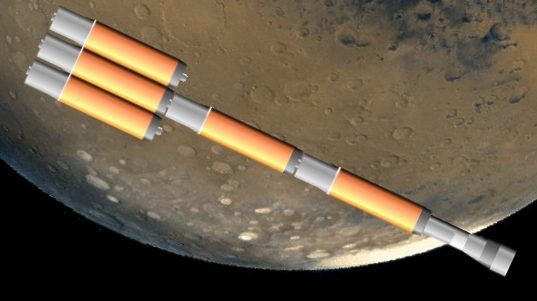
This would use 5 stages, each with a NERVA engine.
What you're probably looking for...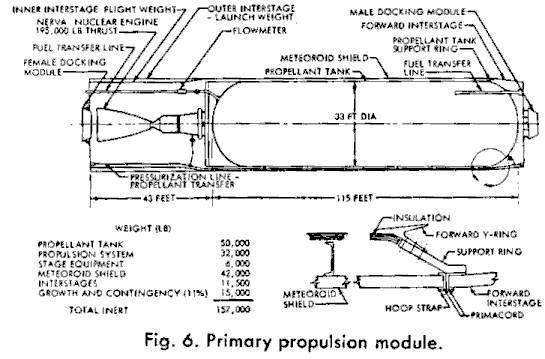
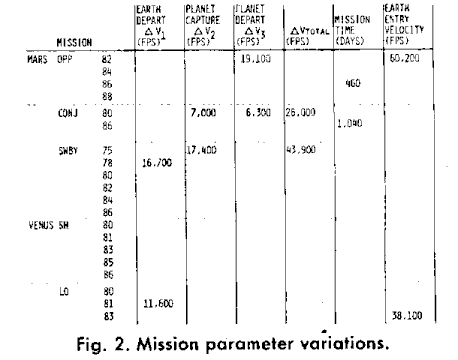
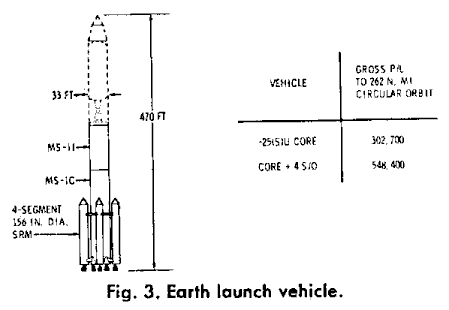
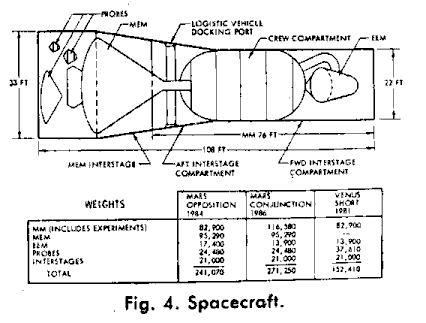
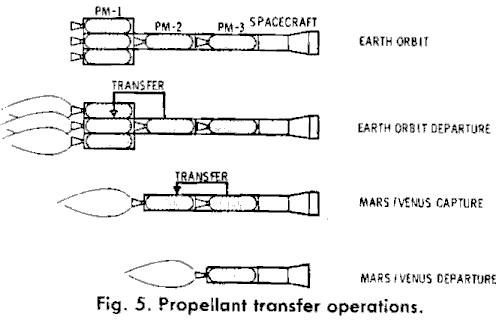
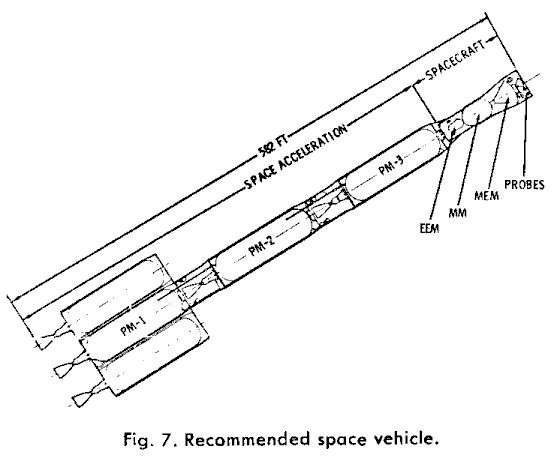
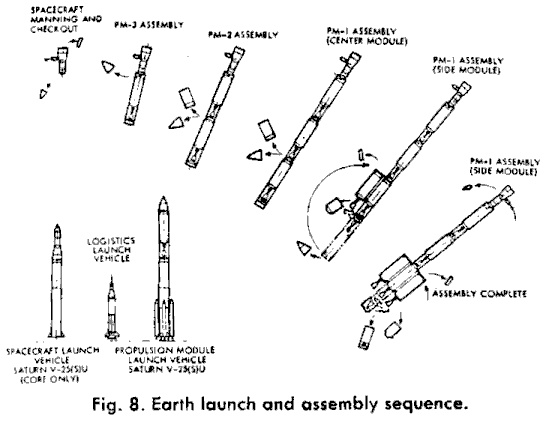
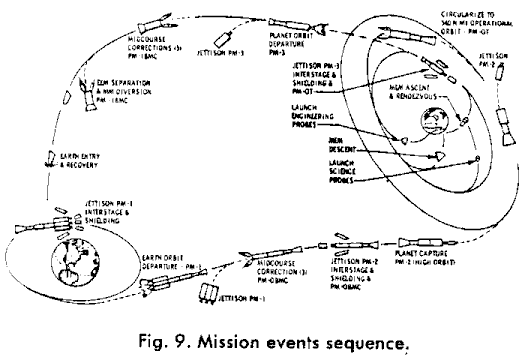
Before that was the NASA Joint Action Group (JAG) Manned Mars Flyby 1966
The linked document is a NASA PDF describing various mission plans. This mission plan starts on page 23 (PDF page 25 including title page).
Offline
Like button can go here
#23 2023-10-03 12:32:54
- kbd512
- Administrator
- Registered: 2015-01-02
- Posts: 8,346
Re: NERVA - 1968 vision for Mars
DARPA and NASA are going 50/50 on a $499M contract to build and test a nuclear thermal rocket engine for CIS-lunar space access and military applications. Lockheed-Martin is partnering with BWX Technologies. L-M provides the vehicle and systems integration expertise. BWXT provides the nuclear reactor core / engine design. I'm guessing that NASA will facilitate testing and provide LH2 and LH2 expertise. Since this project only kicked off this year, it will be at least another 5 years or so before a flight-ready prototype is available. As I understand it, the basic reactor design and materials testing to withstand the heat without cracking has been completed. NASA funded the materials development and non-nuclear hot-flow testing using Hydrogen. NNSA provided the ceramic metal nuclear materials testing. The basic materials technological hurdles have been cleared, but systems integration and hot-flow through the reactor core is where the rubber meets the road. Jackass Flats will inevitably require some facilities renovation, and the spent core will need to be stored in Idaho along with all the spent naval nuclear reactor cores. Beyond that de-fueling will also need to take place before the core (empty reactor vessel, essentially) can be stored in Idaho. Historically, that could've been done in a hot cell at Hanford, but I don't think Hanford is operational anymore. So... De-fueling and nuclear materials storage at NNSA? The details have yet to be worked out.
Offline
Like button can go here
#24 2023-10-03 13:38:34
- RobertDyck
- Moderator
- From: Winnipeg, Canada
- Registered: 2002-08-20
- Posts: 8,291
- Website
Re: NERVA - 1968 vision for Mars
Figure 5 above mentions propellant transfer. I don't understand the benefit of transfer from a forward stage to aft. When the aft stage separates, that just leaves the forward stage less than full. Why? Transfer from side boosters to a core stage makes sense because the side boosters separate first, leaving the core booster completely full.
But there is a newer proposal for Mars that makes more sense. One nuclear thermal engine, and multiple propellant tanks. As a tank is empty, discard it, but keep the engine. So transfer from a forward to aft tank makes sense because the forward tanks will be discarded. Obviously that requires a thrust frame around the tank for integrity when tank is discarded.
Offline
Like button can go here
#25 2023-10-04 14:06:51
- GW Johnson
- Member
- From: McGregor, Texas USA
- Registered: 2011-12-04
- Posts: 6,101
- Website
Re: NERVA - 1968 vision for Mars
It was these types of designs that were "scheduled" for a 1983 Mars mission, around the time of the first Apollo moon landing. That date had been pushed back to 1987, at the end of the Apollo landings in 1972, when Nixon issued the executive order that prohibited all manned spaceflight outside low Earth orbit.
NASA then cancelled further work on NERVA, because "who needs the rocket if we are not going to go?" Ongoing work on NERVA completed by 1974, and that's when everything about it went into mothballs or the scrap heap. Mostly the scrap heap.
And men have never been anywhere but low Earth orbit ever since! (Damn Tricky Dick's hide!)
I have examined the nuclear test range in Nevada using google Earth photos. The 3 sites and some of the buildings used for NERVA are still there, at Jackass Flats. The 4th site used for the nuclear ramjet tests is scraped clean to the rock. Nothing left at all. Most of the railroad tracks connecting these sites is now gone, but there are still a few sidings left, with rail cars on them. That's the rail cars carrying the stuff still too radioactive to approach. That would be the many rocket reactor cores preceding the final NERVA design in Project Rover, and the core or cores tested for the nuclear ramjet in Project Pluto.
East-southeast of there is Frenchman's Flat, where you can still see the dirt roads that led to the test "towns" blown up in nuclear weapons tests. Nothing else remains but those roads. That is where Howard Hughes filmed "The Conqueror" in 1953, an epic about Genghis Khan, with John Wayne in the title role. That is where he contracted his lung cancer, as did all the rest of the cast and crew. That site looked the most like Outer Mongolia, but the blowing dust was radioactive enough to expose movie film inside the steel cans.
North-northeast of there is the Groom Lake airbase, that most folks call "Area 51". I spotted the VOR at the north end of the north runway, on your right as you depart northbound. The photography is quite detailed, but there is some deliberate misinformation still associated with it in the google search engine. There are two hangars, both labeled "hangar 18", one at the north end of the flight line, the other at the south. The runway used to be miles longer than it is now.
Pretty much north of Frenchman's Flat is Yucca Flats, where most of the underground testing was done. That is a very large place. There are very many little collapse craters where these tests were done. The Project Plowshare nuclear excavation crater is actually a tourist attraction there.
The nuclear waste repository we never put into use is the Yucca Mountain facility, pretty much north from Jackass Flats. There's not much to see there on the surface, but by tracing the roads, you can find two entrances for big-rig trucks to the facility, not just one.
GW
Last edited by GW Johnson (2023-10-04 15:41:39)
GW Johnson
McGregor, Texas
"There is nothing as expensive as a dead crew, especially one dead from a bad management decision"
Offline
Like button can go here